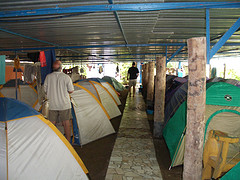Tips for Camping in Costa Rica
 Camping is one of the best ways to experience the many wonders that Costa Rica has to offer. Though, just a decade ago camping on the beach was allowed, today it is prohibited at most beaches and frowned upon at others. Also, there is a certain percentage of crime and often times campers return to find their belongs have disappeared. It is best to select a campground at a state park or reserve for safety.
Camping is one of the best ways to experience the many wonders that Costa Rica has to offer. Though, just a decade ago camping on the beach was allowed, today it is prohibited at most beaches and frowned upon at others. Also, there is a certain percentage of crime and often times campers return to find their belongs have disappeared. It is best to select a campground at a state park or reserve for safety.
A safe and still legal place to camp on the beach is on the shores of the Marino Ballena National Park. The park is named after the annual migration of the Humpback whales that return there each year to spawn. Long stretches of undisturbed white sand offer view of lounging lizards and breeching whales. Camping is allowed on the beach nut there are no amenities.
Santa Rosa National Park and the Guanacaste National Park are among the top picks. Santa Rosa is one of the only remaining dry tropical forest on the planet and the beaches of Naranjo and Nancite are gorgeous and rank among favorites for surfers and campers alike. They offer some of the best camping sites in Costa Rica.
They are very affordable at only $2 per person and offer the following facilities: At the La Casona there are bathrooms and BBQ pits while the sites at Playa Naranjo also offer showers. The sites at Estero Real have out-house toilets and BBQ pits, but no water. Permits are required.
Corcovado National Park is the only remaining old growth rain-forest on the pacific coast of Central America. His park is credited with containing no less than a dozen distinct eco systems that contains highland cloud forests, palm forests as well as lowland rain-forest and mangrove swamps. It contains some of the world’s most endangered species like jaguars, macaws, harpy eagles and the red-backed squirrel monkey.
The park is remote and rugged but the trails are well maintained and the camping sites are on high, well-drained land. Information about particular sites can be obtained at the ranger’s station.